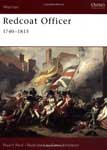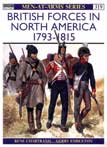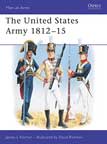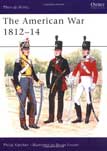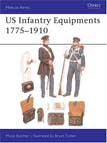

The commissioned officer ranks in the British Army from 1740-1815 were almost entirely composed of the affluent and educated - the sons of the landed gentry, the wealthy, and other professional people. This title looks at the enlistment, training, daily life and combat experiences of the typical British officer in the crucial periods of the North American conflicts, the American Revolution, and the Napoleonic Wars. It compliments the author's previous treatments in Warrior 19 British Redcoat 1740-93 and Warrior 20 British Redcoat (2) 1793-1815, which deal exclusively with the common infantryman, and balances these discussions through a look at the 'fellows in silk stockings'. Particular emphasis is placed on the experiences and activities in North America in the late 18th century.
The end of the American Revolution in 1783 confirmed the independence of the republic of the United States of America from Great Britain. Britain, however, still managed to make its presence felt in North America. Britain's Orders in Council concerning trade were a major irritant which, added to other issues including the sale of Louisiana and the impressment of American soldiers by the Royal Navy, finally caused the United States to declare war on 19 June 1812. This volume examines in detail the organisation, tactics and equipment of the British forces between 1793 and 1815.
The War of 1812 was the true making of the regular regiments and corps of the US Army. Three years' fighting against Britain saw the White House burned down, but also the bloody repulse of the redcoats, then the best infantry in the world, on a number of battlefields. The small constabulary force which entered the war - ill-led, ill-supported, and with an uncertain system of supply - ended it as a professional army with a system of command and services equal to any. This meticulous history of the uniforms of the American regulars is illustrated with many previously unseen paintings and photographs.
Nice British description of the war... Horse puckey! Britain didn't respect the United States and thought it okay to disrespect our Navy and the rights of American Citizens. Guess who won this one too.
Here's the British description: Typically the United States is said to have declared war on Great Britain in 1812 because of the Royal Navy's impressment of American seamen and the British desire to create an Indian buffer state. An Englishman William Cobbett, described the real cause of the conflict: 'There seemed to be wanting just such a war as this to complete the separation of England from America; and to make the latter feel that she had no safety against the former but in the arms of her free citizens.' Regardless of the reasons, however, on 4 June 1812, U.S.President James Madison, asked Congress to declare war.
The development of US Army infantry equipment has been a story of trial and error, of adopting new designs to meet new problems. It was not until 1910 that a whole system of equipment, including everything from the waist belts to the canteens to the cartridge-carriers to the haversack, was officially adopted. Prior to that, each piece of equipment was designed to meet a specific need, without any consideration of anything else the soldier had to carry. Packed with photographs and illustrations, this book explores the history of US Infantry equipments from 1775 to 1910, covering everything from blankets to bayonets.
Origin of Christian Era
Roman garrison of Mainz uprising
Gov Lucius Antonius Saturninus of Germany becomes Emperor of Rome
Last gladiator competition in Rome
King Ataulf of Narbonne marries Emperor Honorius sister Galle Placidia
Albrecht II von Habsburg becomes King of Hungary
Portuguese navigators discover Rio de Janeiro
1st day of the Gregorian calendar in Holland and Flanders
Papal Chancery adopts Jan 1 as beginning of the year (was March 25)
Charles II Stuart crowned King of Scotland
Pro-James II-earl of Danby occupies York
Protestant West-Europe (except England) begin using Gregorian calendar
Russia replaces Byzantines with Julian calendar
Great Britain and Ireland union is in effect, creating United Kingdom
Gen George Washington hoists Continental Union Flag
Quakers in Pennsylvania emancipate their slaves
Albany replaces NYC as capital of New York
Russia appoints 1st Jewish censor to censor Hebrew books
Ireland and Great Britain (England and Scotland) form United Kingdom
Congress prohibits importation of slaves
Official reopening of the White House
William Lloyd Garrison publishes 1st issue of abolitionist journal
1st illustrated weekly magazine in US publishes 1st issue, New York City
Michigan is 1st state to abolish capital punishment
Britain takes Mosquito Coast from Nicaragua
City of Glasgow steamer inaugurates Philadelphia-Liverpool line
1st practical fire engine (horse-drawn) in US enters service
Canada begins using decimal currency system
Porfirio Diaz conquers Mexico City
President Lincoln declares slavery in Confederate states unlawful
Battle of Ft McRee, Florida Battle of Port Royal, SC (Port Royal Ferry)
1st homestead under the Homestead Act claimed, near Beatrice, Nebr
Battle of Galveston, Texas-Confederates recapture the city
Emancipation Proclamation (ending slavery) issued by Lincoln
Building of Panama Canal, begins
Cuba liberated from Spain by US (National Day) (US occupies till 1902)
President Theodore Roosevelt shakes a record 8,513 hands in 1 day
South Australia transfers Northern Territory to federal government
Sun Yat-sen forms Chinese Republic
Union of Socialist Soviet Republics established
Russian general Zhukov appointed chief of general staff
US and 25 other countries sign a united declaration against the Axis
Gen Clark replaces General Patton as commander of 7th Army
German air raid on allied airports at Eindhoven / Saint-Trond / Brussels
Emperor Hirohito of Japan announces he is not a god
Ho Chi Minh begins offensive against French troops in Indo China
Massive Chinese / North Korean assault on UN-lines
France returns Saar to becomes the 10th state of German Federal Rep
Sammy Davis Jr marries Loray White
Treaties establish European Economic Community (Common Market)
Castro leads Cuba to victory as Fulgencio Batista flees to Dom Rep
US census at 179,245,000
Houston Oilers beat LA Chargers 24-16 in AFL championship game
Largest check issued, National Bank of Chicago to Sears ($960.242 billion)
Russia introduces a new ruble worth $1.11
Federation of Rhodesia and Nyasaland dissolved
Tonga revises constitution
Netherlands gets color TV
WDCO TV channel 15 in Cochran, Georgia (PBS) begins broadcasting
"The Epoch" (Time 0 for UNIX systems, Midnight GMT)
Afro-American Historical Calendar Series Established
Netherlands Christian Workers Union (NCW) forms
Britain, Ireland and Denmark become 7th-9th members of Common Market
West African Economic Community formed (Benin, Ivory Coast, Mali, Mauritania, Niger, Senegal, Upper Volta)
Haldeman, Ehrlichman, Mitchell and Mardian convicted of Watergate crime
Sweden adopts constitution
President Ford signs 1st major revision of copyright law since 1909
US and China (Peoples Republic) begin diplomatic relations
International Decade of Water & Sanitation begins
Greece is 10th country to join European Economic Community
Palau (Trust Territory of Pacific Is) becomes self-governing
30 Something stars Ken Olin and Patricia Wettig meet, later they marry
Pope John Paul II prays for an end to martial law in Poland
TA launches 5 year capital program to overhaul NYC subway system
Spain and Portugal are 11th and 12th to join European Economic Community
60 bodies recovered in Dupont Plaza Hotel fire in Puerto Rico
New York City transit fare rises from $1.00 to $1.15
David Dinkins sworn in as 1st black Mayor of New York City
FCC implements "SYNDEX" giving independent stations more rights over cable TV outlets for exclusive syndicated programs
Iraq rejects peace proposal from Egyptian President Hosi Mubarak
Bush is 1st US President to address Australian Parliament
Curacao becomes 1st in Dutch Antilles to have compulsory education
Europe breaks down trade barriers
International Space Year begins
12 member European Economic Community set up vast free trade zone
Czechoslovakia separates into Czech Republic (Bohemia) and Slovakia
Microsoft CEO Bill Gates (38) marries Melinda French (29)
North American Free Trade Agreement (NAFTA) goes into effect
"Shadow Box" closes at Circle in the Square Theater NYC after 49 performances
Austria, Finland and Sweden act to join European Union
Fernando Henrique Cardoso installed as President of Brazil
Last "Far Side" by cartoonist Gary Larson (started 1980)
After 27 years, Betty Rubble debuts as a Flintstone vitamin
Curacao gains limited form of self rule (Status Aparte)
All California bars, clubs and card rooms must be smoke-free
US Census Bureau estimates population at 268,921,733
